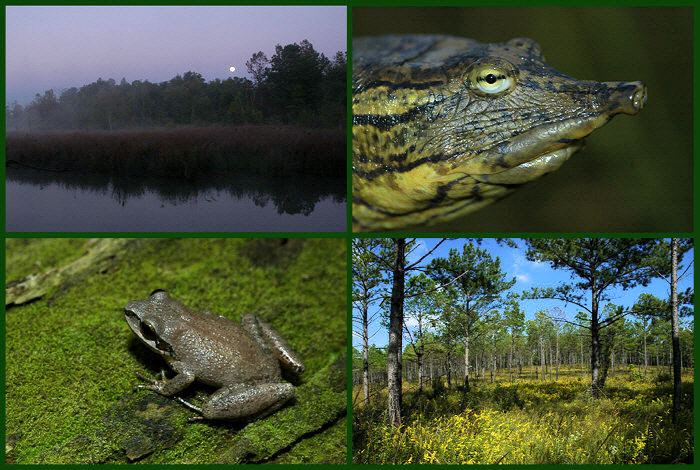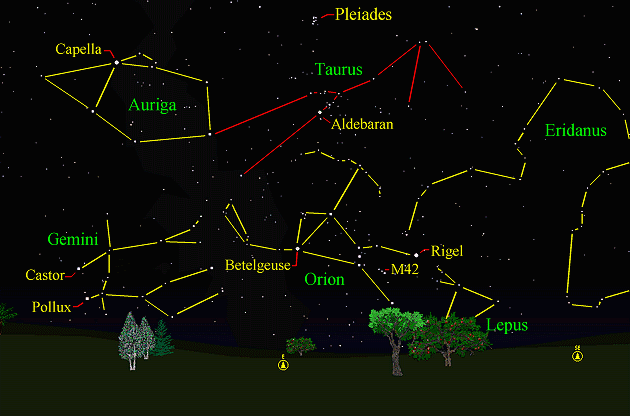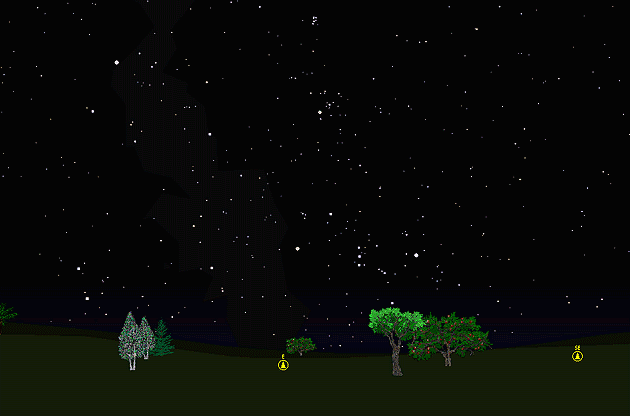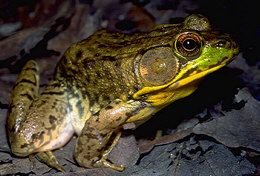The purpose of this feature is to give scout leaders, educators and naturalists an idea of some of the natural events coming up each month. We will try to cover a variety of natural events ranging from sky events to calling periods of amphibians, bird and mammal watching tips, prominent wildflowers and anything else that comes to mind. We will also note prominent constellations appearing over the eastern horizon at mid-evening each month for our area for those who would like to learn the constellations. If you have suggestions for other types of natural information you would like to see added to this calendar, let us know! Note: You can click on the hyperlinks to learn more about some of the featured items. To return to the Calendar, hit the "back" button on your browser, NOT the "back" button on the web page. All charts are available in a "printer friendly" mode, with black stars on a white background. Left clicking on each chart will take you to a printable black and white image.
Notes and Images From October 2006
In October we were once again doing wildlife inventories at Ft. McClelland in Anniston, Alabama. Walking the wet fields we were treated to Sedge Wrens, an American Bittern, a Virginia Rail, several Sora and many other migrants. We also spotted a Mountain Chorus Frog crossing an old road bed in a forested part of the range, a rare treat this time of year.
Sky Events for November 2006: The Leonid Meteor Shower peaks on the evening of November 18th and the early morning hours of November 19th. This should be a good shower, and the moon will not interfere with observing. The Leonids are my personal favorite of the annual meteor showers. Sleeping bags, reclining lawn chairs (carry them out with you, if you leave them out earlier, they'll be wet with dew) and a warm beverage makes for a very enjoyable experience. For more about meteor showers, see "A November Tradition." Mercury marches across the face of the sun on November 8th, beginning at 1:12pm CST. Do not ever look at the sun with the naked eye or any type of optical instrument unless you have a safe solar filter or are projecting the image onto a white card. Permanent serious damage to the eyes (including blindness) can result, even if you feel no pain at all. The transit lasts until after sunset. The next transit of Mercury will not occur until May 9th, 2016. Evening Sky: Uranus is well placed for viewing with binoculars this month, near Lambda in Aquarius. Lambda and Uranus are due south around 7:00pm CST at mid-month. See the notes and finder charts from the October 2006 Natural Calendar. The moon will not interfere from November 10th through November 24th. For tips on attempting to see Uranus with the naked eye, see "Seeing in the Dark." Saturn rises around 11:30pm at mid-month. Morning Sky: Mercury emerges from the solar glare towards the end of the month after its transit on November 8th. On November 25 it reaches greatest western elongation, rising about 1-1/2 hours before the sun. Look for it low in the eastern sky before sunrise. All times noted in the Sky Events are for Franklin, Tennessee and are Central Standard Time. These times should be pretty close anywhere in the mid-state area. Constellations: The views below show the sky looking east at 9:00pm CST on November 15th. The first view shows the sky with the constellations outlined and names depicted. Star and planet names are in yellow. Constellation names are in green. The second view shows the same scene without labels. Auriga, the Charioteer, with its bright star Capella, and Taurus, the Bull, with its bright star Aldebaran, are well up into the eastern sky. Look for the Pleiades, a beautiful open star cluster, above Aldebaran. Look for the bright stars Castor and Pollux as the constellation Gemini, The Twins, clears the horizon. Saturn is just below the horizon beneath Castor and Pollux, and a line drawn between these two stars will point to Saturn. Due east, mighty Orion clears the horizon with its bright stars Betelgeuse and Rigel. Note the difference in color between the two stars. Betelgeuse is a red giant and looks orange. Rigel is very hot supergiant and looks bluish. Looking at the center of the three "sword" stars with binoculars, you can see M42, the Orion Nebula. Just poking its head above the horizon is Lepus, The Hare.
On Learning the Constellations: We advise learning a few constellations each month, and then following them through the seasons. Once you associate a particular constellation coming over the eastern horizon at a certain time of year, you may start thinking about it like an old friend, looking forward to its arrival each season. The stars in the evening scene above, for instance, will always be in the same place relative to the horizon at the same time and date each November. Of course, the planets do move slowly through the constellations, but with practice you will learn to identify them from their appearance. In particular, learn the brightest stars for they will guide you to the fainter stars. Once you can locate the more prominent constellations, you can "branch out" to other constellations around them. It may take you a little while to get a sense of scale, to translate what you see on the computer screen or what you see on the page of a book to what you see in the sky. Look for patterns, like the stars that make up Orion. The earth's rotation causes the constellations to
appear to move across the sky just as the sun and the moon appear to do.
If you go outside earlier than the time shown on the charts, the constellations
will be lower to the eastern horizon. If you observe later, they will
have climbed higher. As each season progresses, the earth's motion around the sun causes the constellations to appear a little farther towards the west each night for any given time of night. If you want to see where the constellations in the above figures will be on December 15th at 9:00pm CST, you can stay up till 11:00pm CST on November 15th and get a preview. The westward motion of the constellations is equivalent to two hours per month. A good book to learn the constellations is H. A. Rey's
classic, The Stars, A New Way to See Them. Rey's depictions of the
constellations and witty commentary are terrific. A good general reference book on astronomy is the Peterson
Field Guide, A Field Guide to the Stars and Planets, by Pasachoff.
The book retails for around $14.00. A good beginners software program for learning the night sky is the Starry Night Beginner program. Visit the Starry Night web site at www.starrynight.com The program retails for around $30.00 and contains a wealth of information.
Amphibians:
We think of November as the quietest time of year for Tennessee frogs and toads. However, some song can still occasionally be heard. Listen for Spring Peepers, Southeastern Chorus Frogs and Southern Leopard Frogs. Checking around ponds at night with a flashlight held next to your temple will many times show the eye shine of Southern Leopard Frogs, Green Frogs and Bullfrogs. As in October, you can locate many of the frogs and toads that have been calling more frequently earlier in the year by driving the back roads slowly on rainy nights. This is a two person job. One person watches the road for amphibians and one person looks out for other vehicles.
Birds: You probably have already put out your bird feeders, but if you haven't you'll be missing out on a lot of good looks at winter feeder birds. This is a great time of year to start learning bird identification. Watch and listen for fall arrivals like White-throated and White-crowned Sparrows, Yellow-bellied Sapsuckers, Red-breasted Nuthatches and Brown Creepers. Listen for Great Horned Owls dueting at dusk and dawn and sometimes through the night during their courtship period. Recommended: Bird Finding in Tennessee, Michael Lee Bierly. A classic guide to finding birds in Tennessee. The Sibley Guide to Birds, David Allen Sibley The Sibley Guide to Birds of Eastern North America, David Allen Sibley A Field Guide to the Birds of Eastern and Central North America, 5th edition. 2002. Roger Tory Peterson and Virginia Marie Peterson. If it's been a while since you've picked up a Peterson bird guide, you may be pleasantly surprised by the large image scale of the drawings. An inexpensive guide for beginners is the Golden Guide for Birds.
Archives (Remember to use the back button on your browser, NOT the back button on the web page!) Natural Calendar September 2006 Natural Calendar February 2006
Natural Calendar
December 2005
Natural Calendar
November 2005
Natural Calendar
September 2005
Natural Calendar
February 2005
Natural Calendar
December 2004
Natural Calendar
November 2004
Natural Calendar
September 2004
Natural Calendar
February 2004
Natural Calendar
December 2003
Natural Calendar
November 2003
Natural Calendar
September 2003 Natural Calendar February 2003 Natural Calendar December 2002 Natural Calendar November 2002 Nature Notes Archives: Nature Notes was a page we published in 2001 and 2002 containing our observations about everything from the northern lights display of November 2001 to frog and salamander egg masses. Night scenes prepared with Starry Night Pro software All images and recordings © 2006 Leaps
|



